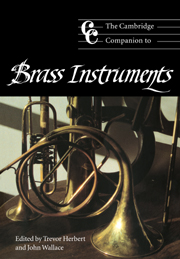Book contents
- Frontmatter
- Introduction
- 1 Lip-vibrated instruments of the ancient and non-western world
- 2 How brass instruments work
- 3 Design, technology and manufacture before 1800
- 4 Brass instruments in art music in the Middle Ages
- 5 The cornett
- 6 ‘Sackbut’: the early trombone
- 7 The trumpet before 1800
- 8 The horn in the Baroque and Classical periods
- 9 Design, technology and manufacture since 1800
- 10 Keyed brass
- 11 The low brass
- 12 Brass in the modern orchestra
- 13 Brass bands and other vernacular brass traditions
- 14 Playing, learning and teaching brass
- 15 The post-classical horn
- 16 Jazz, improvisation and brass
- 17 Brass solo and chamber music from 1800
- 18 Frontiers or byways? Brass instruments in avant-garde music
- Glossary
- Notes
- Select bibliography
- Index
13 - Brass bands and other vernacular brass traditions
Published online by Cambridge University Press: 28 September 2011
- Frontmatter
- Introduction
- 1 Lip-vibrated instruments of the ancient and non-western world
- 2 How brass instruments work
- 3 Design, technology and manufacture before 1800
- 4 Brass instruments in art music in the Middle Ages
- 5 The cornett
- 6 ‘Sackbut’: the early trombone
- 7 The trumpet before 1800
- 8 The horn in the Baroque and Classical periods
- 9 Design, technology and manufacture since 1800
- 10 Keyed brass
- 11 The low brass
- 12 Brass in the modern orchestra
- 13 Brass bands and other vernacular brass traditions
- 14 Playing, learning and teaching brass
- 15 The post-classical horn
- 16 Jazz, improvisation and brass
- 17 Brass solo and chamber music from 1800
- 18 Frontiers or byways? Brass instruments in avant-garde music
- Glossary
- Notes
- Select bibliography
- Index
Summary
Virtually every major involvement of the lower social orders with brass instruments in western cultures dates from the nineteenth century. There are exceptions of course; Moravian trombonists were not professional players, and there are instances of horn and trumpet calls being sounded by enlisted military musicians. However, the engagement of masses of ordinary working people with brass instruments, both as players and listeners, starts between 1830 and 1850.
The idea that the brass players who populated Europe from the Middle Ages – alta band players, waits, Stadtpfeifer, court or church musicians, state trumpeters or whatever else they were called – were connected to, or had a causal relationship with, the amateurs who bought valve instruments in the nineteenth century is spurious. To deny the compelling reality that widespread amateur brass playing was new in the nineteenth century, a feature of modernity, is to misunderstand one of the most remarkable sociological shifts to have occurred in the history of music. Almost anyone who, in say 1820, possessed a sophisticated skill on an artmusic instrument and did not make a living at it was, virtually by definition, an aristocrat or a member of the wealthy bourgeoisie. Yet, within a single generation, such skills were commonplace among amateur brass band players across Europe and America. It was a moment of vast importance; it led to changes in the idiom of many brass instruments, and it was one of the ways in which sophisticated music making can genuinely be said to have contributed to social emancipation.
- Type
- Chapter
- Information
- The Cambridge Companion to Brass Instruments , pp. 177 - 192Publisher: Cambridge University PressPrint publication year: 1997
- 2
- Cited by



